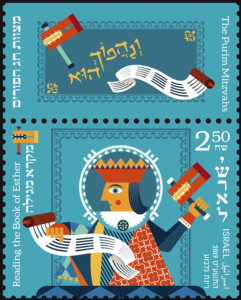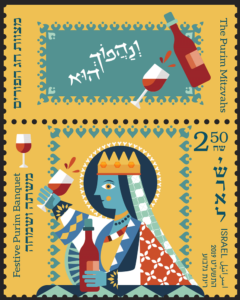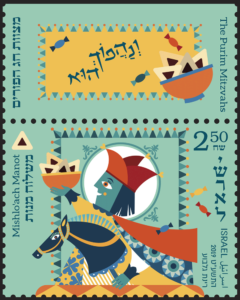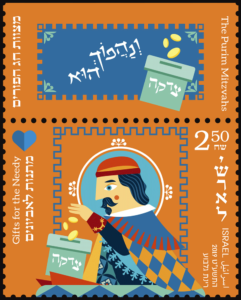Issue Date: March 5, 2019
[press release]
Purim is a joyous festival that celebrates saving the Jews from enemies who wished to destroy them. The Book of Esther tells of how “the very day on which the enemies of the Jews had expected to get them in their power, the opposite happened, and the Jews got their enemies in their power” (9:1). The phrase “the opposite happened” has become one of the central themes of Purim. Thus, the stamps in this Purim mitzvahs series are reversed, and for the first time in Israel’s history, the tabs are attached at the top of the stamps rather than to the bottom.
It is written in the Book of Esther that Mordecai instructed Jews throughout the Persian kingdom to celebrate Purim each year, “to observe them as days of feasting and merrymaking, and as an occasion for sending gifts to one another and presents to the poor” (9:22). Based on this verse, the Jewish wise men formulated the four Purim mitzvahs, and these are presented on the stamps by four characters from the Book of Esther.
Reading the Book of Esther
The Book of Esther notes that “these days are recalled and observed in every generation” (9:28). The Jewish wise men learned from this verse that all Jews are obligated, men and women alike, to read the Book of Esther. One may read it alone or hear it read aloud in the synagogue. This mitzvah is depicted on the stamp by King Ahasuerus, who had the book of memories read to him when he could not sleep at night.
Festive Purim Banquet
 The lavish banquets hosted by King Ahasuerus and Queen Esther are well documented in the Book of Esther. The events that led to the Jews being saved occurred during these banquets. The Jewish wise men emphasized the importance of drinking wine during the Purim celebration and the Amora Rava even asserted that people must get drunk on Purim. This mitzvah is represented on the stamp by Queen Esther. The feast to which Esther invited Ahasuerus and Haman brought about the downfall of the Jews’ enemy.
The lavish banquets hosted by King Ahasuerus and Queen Esther are well documented in the Book of Esther. The events that led to the Jews being saved occurred during these banquets. The Jewish wise men emphasized the importance of drinking wine during the Purim celebration and the Amora Rava even asserted that people must get drunk on Purim. This mitzvah is represented on the stamp by Queen Esther. The feast to which Esther invited Ahasuerus and Haman brought about the downfall of the Jews’ enemy.
Mishlo’ach Manot
 The Jewish wise men learned from the words “sending gifts (plural) to one another (singular) that everyone must send two types of food. A bowl of oznei haman, one of the symbolic foods of Purim, is shown in the hands of one of King Ahasuerus’ horseman, whose role was to deliver the King’s decrees throughout the kingdom.
The Jewish wise men learned from the words “sending gifts (plural) to one another (singular) that everyone must send two types of food. A bowl of oznei haman, one of the symbolic foods of Purim, is shown in the hands of one of King Ahasuerus’ horseman, whose role was to deliver the King’s decrees throughout the kingdom.
Gifts for the Needy
The Jewish wise men deduced from the words “gifts (plural) to the poor (plural)” that each person must give at least two gifts or monetary contributions to two different needy individuals. Over the years numerous Jewish scholars, such as Maimonides,  emphasized that “it is preferable for one to give numerous gifts to the needy than to expand his feast or increase his gifts to peers”. This important mitzvah is represented on the stamp by Mordecai who, according to the Book of Esther “was highly regarded by the Jews” (10:3).
emphasized that “it is preferable for one to give numerous gifts to the needy than to expand his feast or increase his gifts to peers”. This important mitzvah is represented on the stamp by Mordecai who, according to the Book of Esther “was highly regarded by the Jews” (10:3).
* With thanks to Moshe Rimer for his content advice.
Technical Specifications:
Name: The Purim Mitzvahs
• Reading the Book of Esther,
• Festive Purim Banquet,
• Mishlo’ach Manot,
• Gifts for the Needy
Date of Issue: 05 March 2019
Denominations: NIS 2.50, 2.50, 2.50,2.50
Size of Stamp:
Size of Booklet: W: 40 mm H: 30
Plate nos.: 1111
Designers: Rinat Gilboa
Printers: Cartor Security Printing, France
Printing method: Offset
Sheet type: Mini Special Sheet (Teth Besh Sheet)
No. of stamps in sheet: 8 (8 tabs)
Place of cancellation: Jerusalem
No. of FDCs: 2
Price of FDCs: NIS 6.20 , 6.20



